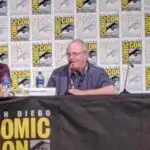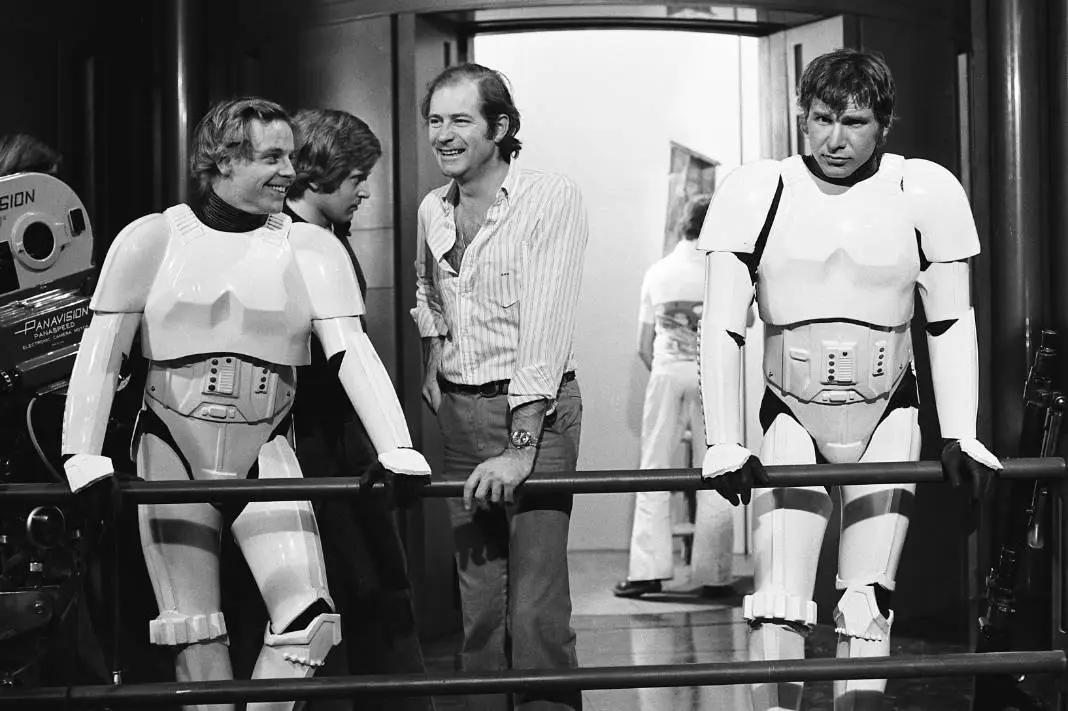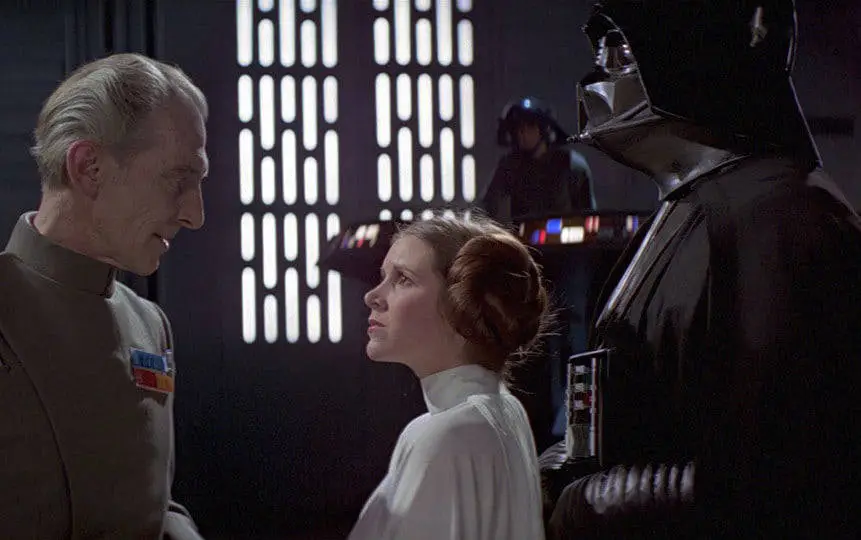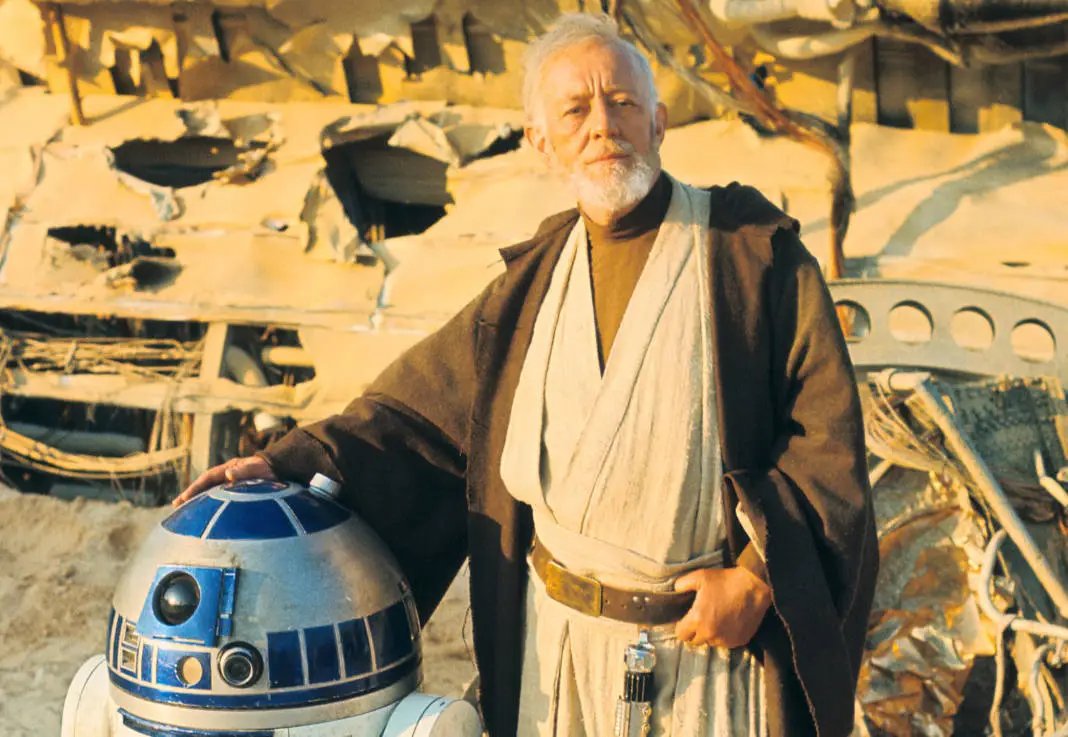In the run-up to the release of Star Wars: The Rise of Skywalker and the end of the Skywalker Saga, we will be taking a look back at all of the Saga films and re-evaluating them and their legacy as a whole.
Star Wars: Episode IV A New Hope
Or just Star Wars. Or A New Hope, depending on what it was called when you saw it first. This seems like nitpicking, but by this point, the conversation on Star Wars is held up by a giant bed of nits. More has been written over the last two decades about what the real A New Hope is than what A New Hope is. Then again, what can be said about it which hasn’t been said before?
More importantly, what can be said which hasn’t become hackneyed, clichéd or worse — conventional wisdom — after decades of focus on it? Including that opening sentence, which must have launched an untold number of previous look-backs.
Like the great classics of the Golden Age of Hollywood, it is obviously old (and getting older) when viewed next to the modern incarnations. And like those classics, it’s also timeless, at least in part because it was designed to be. The fact that it succeeded at that design better than anyone making it could have predicted is luck as much as skill, but that’s the way art is.

[A lot has also been written, and even more believed, about how Star Wars was made and who is responsible for what’s in it. This is not the place to go over all of that again. If you do have questions or ideas on those areas, read any of the first-hand accounts that have been published over the decades, especially J.W. Rinzler’s excellent The Making of Star Wars, and ignore what you read on blog posts.]
If it is a timeless classic (and it is), the best starting point must be how it is different from its cohorts. Its closest peer at this point would be James Bond films or classic Disney cartoons, but while those tend to be the same thing for all people, Star Wars is not. Like a living, eternal symbol of the generation gap, each new introduction says something about and to the audience it is brought in front of.
That first audience was baby boomers and their children emerging from the haze of Vietnam, Watergate, and the collective loss of innocence we seem to have decided the 1970s were. Ground down with endless war, a moribund economy, and ongoing rebellion against the societal systems underpinning the country, the time was ripe for an old-fashioned good versus evil fairy tale that didn’t ask too much of the audience and left them feeling happy.
Writer-director George Lucas (with some helping hands from his American Graffiti co-writers Willard Hyuck and Gloria Katz) was not the first person to realize that or attempt it – Hollywood was still making plenty of light-hearted comedies and adventure films in the 70s before Star Wars – but he did better than anyone else at least in part by looking to the past.
Starting with its now iconic opening line — “A Long Time Ago, In A Galaxy Far, Far Away…” — Star Wars boldly announces its intention to retreat to a simpler time when the world was easier to understand. Retreat it does, so far, in fact, that any attempts to move forward, which would come later, would be seen as more transgressive than they really were.
The villains are overly simplistic (an issue the series would spend most of its lifespan dealing with) — totalitarians who want to control everyone because that’s what totalitarians do — and the heroes are easy-to-understand archetypes from narrative history: a gallant knight, a captured princess, a reluctant gunslinger, a young farmer anxious to leave the farm.
The influence of medieval/fantasy literature (above almost any other form) rears its head as soon as the words ‘Jedi Knight’ are spoken, and most of the other major narrative pieces Lucas grabbed at are related to that in some way. The westerns of Lucas’ youth are more clearly on display as an influence in A New Hope (including one direct lift from The Searchers) than any other film in the series.
At the same time, however, they (and the Japanese samurai films, which themselves were heavily influenced by American westerns of the ’30s and ’40s) are really just a gateway drug to this older form of white knight/black knight conflict. The Westerns were the appropriation of those old chivalric romance traits the way Star Wars appropriated the Western. It would be easy to call this a ‘happy accident’ — the foundation of much great art — if Lucas hadn’t gone further and further into the form in his later episodes.
In hindsight, Lucas’ reach back to that older style of storytelling is easy to see. In the moment, it is more bound up with the pieces of pulp material from his youth he was confiscating — the aforementioned westerns and samurai films, Flash Gordon and Buck Rogers serials — flung onto a young man’s concern over modern geopolitics (so evident in his college short films and early Zoetrope work).
Delving into older medieval styles (and the well-documented interest in mythological archetypes) eventually sent him towards the underpinnings of those forms… the classical epic. Star Wars, whether anyone meant it to be or not (and really, how could you mean for it), is as close as we’ve come in the present day to a classical epic. It could be, and probably has been, translated into some sort of verse and would not seem that different from the adventures of Siegfried or Aeneas.
Of course, just as Star Wars was not the only piece of light entertainment being produced in Hollywood in the ’70s, it was also not the only one looking to the past. There may be nothing Hollywood likes as much as re-appropriating its older triumphs over and over and then patting itself on the back. If that was all it took to create something of as much cultural resonance as A New Hope has even 40 years later, there would be a lot more of them lying around. Lucas’ inspirations stretched further than that, more reminiscent of the reach of New Wave filmmakers in Europe than studio directors working on just another piece of slick entertainment.
As much as has been written about who is truly responsible for Star Wars, even more has been written about its influences (and the commandment about where to go for more information on that discussion is repeated here). What’s more important than what went into the stew is how Lucas syncretized all the disparate pieces into a new whole. In that sense, A New Hope is a sort of found art, though for the audience it was made, the initial pieces were so obscure no one would have recognized it as such if it hadn’t become so popular.
More important than any of its influences, though, is the fact that Star Wars, whether anyone knew it or not, was also made for the future.
Not just because it wraps its antecedents in a veneer of futurism, although this is one of the prime decisions that made Star Wars what it is. A straightforward romantic fantasy featuring knights in armor fighting an evil wizard would not have made near the impact A New Hope did. By moving those older tropes into a new form, they were made new again and, more importantly, gave Lucas an impetus to engage in what the old epic writers and orators did and create the defining mantra of modern big-budget studio filmmaking: world-building.
Knowingly or not (and I suspect the answer is ‘more knowingly than not’), Lucas took his one great shot with studio toys (what Orson Welles once called ‘the world’s greatest trainset’) and pushed forward with both hands, trying to see how far he could go aesthetically, technologically, spiritually.
Lucas’ invention of the Force is the perfect vessel for his various Buddhist leanings because it barely exists. It’s more of a quick elide than a spiritual treatise, existing primarily as a plot mechanic so that Lucas doesn’t have to say ‘magic’. Most everything good in Star Wars, and particularly in A New Hope, exists that way – a requirement for some short-term dramatic problem that eventually takes on a life of its own. The screenplay for A New Hope, like Lucas’ best writing, is spare. For all of the groundwork it ends up laying, it is not the type of film to get hung up on exposition or deep character expiation.
[This leaves the characters being more like quickly-sketched archetypes than characters, which would make them extremely difficult to care for if they weren’t contradictorily so alive. For all of Lucas’ perceived shortcomings as a writer, Star Wars is filled with iconic characters, and most of them — Han Solo, Darth Vader, Darth Maul, Ahsoka Tano, and Yoda — come directly from his pen. Some of that is down to the charisma of the actors playing the roles, but they’re also constantly placed in not just lived-in spaces but lived-in circumstances. It’s no accident Star Wars frequently focuses on people simply eating or going about some other mundane activity.]
Nor does anyone ever lay out major mythological concepts or the mechanics of backstories beyond what is needed to get to the next scene, letting us discover the world as we go. Major signposts are pointed out once — get the droids to Obi-Wan Kenobi, find the Princess, try to reach the Death Star’s one weakness — rather than hammered home. The story is told to us rather than at us, allowing the plot to maintain a propulsive forward momentum, which is always, as Lucas famously said, ‘faster and more intense.’ It’s a particular and peculiar method that only works as well as it does because this is the first film but also because Lucas has the constant confidence that everyone will be able to keep up with it.
If there was anything its various descendants would emulate more and don’t, it’s that.
So much else is audacious about it, though. Even if it had been the small hit Lucas’ initially predicted, it probably would have still been hugely influential. The list of breakthroughs on the craft level – from its Ralph McQuarrie’s concept art to visual effects to sound to John Williams’ score (potentially the greatest ever recorded) — has been as thoroughly covered as the making of the film itself. Entire films have been made about the leaps forward in visual and sound effects, but they are not the only great innovations A New Hope managed. The work in editing and art direction is just as important and just as influential, even if it doesn’t get written about as much.
Much as with the autocratic underground world of THX-1138, the world of the Empire in A New Hope is all monochromatic — all blacks and whites and greys and little in between — contrasted with the earth tones of its opposition, reveling in the reality of nature. It underscores and makes more obvious the technology versus nature themes, which were one of the subtler elements of the first films and eventually fell by the wayside in favor of other elements.
As with its other influences, this is an idea that did not originate with A New Hope — Kubrick had clearly intuited the idea of monochromatic color schemes to represent a sterile and unchanging techno society in 2001: A Space Odyssey — but certainly found its clearest presentation there. It’s from this that much of Lucas’ famed ‘used aesthetic’ appears as the positive technology – the Rebel hideout and the interior of Han Solo’s famed Millenium Falcon – are made grimy and gritty to offset the spotless Imperial environs. It’s not God that cleanliness is next to in Star Wars.
It speaks to how timeless A New Hope has become that we take in so much of its art direction as it tends to whiz by so fast that it requires multiple views to form an opinion. Picking up the gauntlet thrown by Peter Hunt on the early James Bond films, Lucas and his editing team reduce and reduce and reduce the amount of time an image can remain on screen and still be comprehended. The speed aesthetic hits its peak in the various space battle sequences — the Falcon’s escape from the Death Star (edited by Lucas by hand) and the final attack on the Death Star (primarily edited by his wife, Marcia) — where information is reduced down to individual frames at points.
It’s no accident that Lucas’ other great skill is the development of his action sequences. They’re built from both the natural inventiveness that fed his world-building and his interest in montage. Even years later, his best set pieces feel as if they could have been made today.
None of which means A New Hope is without flaw. The script, though a blueprint for action cinema now, works frequently as an afterthought. Stage-trained actors like Alec Guinness and Peter Cushing were able to breathe life into anything, and Harrison Ford leaned into his considerable charisma, but anything dealing with emotion was stylized in such a way actors and audiences had a hard time grabbing onto it, particularly Hamill. That is maybe the most important thing that can be said about A New Hope as a Star Wars film, as it would become more and more a part of the saga as time went on.
It’s also, finally, a film pushing against its limits on all sides, particularly its budgetary constraints. Sequences go from state-of-the-art to flimsy at the drop of the hat. It moves so fast it’s easy to miss how quickly it comes together or how impatient Lucas is with some of his moments. The mythology, so quickly sketched out and never lingered on, also allowed gaps for its audience to fill in, eventually creating a near-religion which, like the idolaters on Mount Sinai, threatened to consume its leader and everything around it. Sometimes specification really is necessary or else you end up with idle hands and devils and all that.
But, like Bacon said, ‘There is no beauty that hath not some strangeness in its proportion.’ It is not (and this is as true for all of Star Wars as for its initial episode) in spite of its weaknesses that A New Hope is great, but because of them.
Rating: 10/10 (Buy A New Hope at Amazon)
NEXT: STAR WARS: EPISODE V THE EMPIRE STRIKES BACK

Joshua Starnes has been writing about film and the entertainment industry since 2004 and served as the President of the Houston Film Critics Society from 2012 to 2019. In 2015, he became a co-owner/publisher of Red 5 Comics and, in 2018, wrote the series “Kulipari: Dreamwalker” for Netflix. In between, he continues his lifelong quest to find THE perfect tomato soup and grilled cheese sandwich combination.


